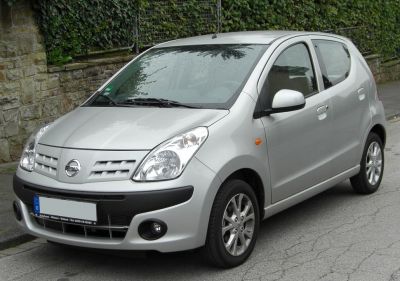 2000 Toyota Yaris I (3-door) Dimensions, Size & Specs
2000 Toyota Yaris I (3-door) Dimensions, Size & Specs
Measurements of the 2000 Toyota Yaris I, engineered for optimal performance and comfort
| Dimensions | |
|---|---|
| Length: | 3615 mm142.3 in11.9 ft |
| Width: | 1660 mm65.4 in5.4 ft |
| Height: | 1500 mm59.1 in4.9 ft |
| Trunk Capacity: | 305 liter10.8 cu ft |
| Trunk Capacity (Max): | 950 liter33.5 cu ft |
| Weight Specifications | |
| Curb Weight: | 830-1025 kg1830-2260 lbs |
| Maximal permitted Weight: | 1320-1400 kg2910-3086 lbs |
| Tire Specifications | |
| Rims Sizes: |
|
| Tire Sizes: |
|
The Toyota Yaris I (3-door) generation, produced between 1999 and 2003 and released for the 2000 model year, represents a compact and practical hatchback ideal for urban driving. Measuring 3,615 mm (142.3 inches) in length, 1,660 mm (65.4 inches) in width, and 1,500 mm (59.1 inches) in height, this model emphasizes a small footprint without sacrificing interior versatility. Its curb weight ranges from 830 kg to 1,025 kg (1,830 to 2,259 lbs), reflecting its lightweight construction that contributes to fuel efficiency and nimble handling. The maximum permissible weight spans from 1,320 kg to 1,400 kg (2,910 to 3,086 lbs), accommodating passengers and cargo comfortably. Luggage space is a highlight of the Yaris I hatchback, offering 305 liters (10.8 cubic feet) of capacity with rear seats upright and an expanded 950 liters (33.5 cubic feet) when the rear seats are folded down, enhancing its practicality for everyday use or small trips. The vehicle is equipped with multiple rim options ranging from 13 to 15 inches, with compatible tire sizes including 155/80 R13 T, 175/65 R14 T, 175/65 R14, and 185/55 R15 H, ensuring flexibility in tire selection for varying driving needs. The Toyota Yaris I (3-door) stands out as an efficient and maneuverable compact hatchback, perfectly suited for city dwellers seeking reliability, ease of parking, and adaptable cargo capacity in the early 2000s automotive landscape.
Discover the standout features that make the 2000 Toyota Yaris I a leader in its class
Have a question? Please check our knowledgebase first.
The Toyota Yaris I (3-door), produced between 1999 and 2003, measures 3615 mm (approximately 142.3 inches) in length, 1660 mm (about 65.4 inches) in width, and 1500 mm (roughly 59.1 inches) in height. These compact dimensions contribute to its agility and ease of maneuverability in urban environments.
This generation of the Yaris has a curb weight ranging from 830 kg to 1025 kg (about 1830 to 2260 lbs), depending on the configuration and options. Its maximum permissible weight spans from 1320 kg to 1400 kg (approximately 2910 to 3086 lbs), allowing it to carry passengers and cargo well within safe limits while maintaining fuel efficiency.
The Toyota Yaris I offers a practical luggage capacity of 305 liters (about 10.8 cubic feet) with the rear seats upright, suitable for daily errands and small trips. When the rear seats are folded down, the cargo space expands significantly to 950 liters (approximately 33.5 cubic feet), making it versatile for transporting larger items or luggage.
This generation supports various rim sizes including 13-inch, 14-inch, and 15-inch options. Correspondingly, tire sizes that fit include 155/80 R13 T, 175/65 R14 T, 175/65 R14, and 185/55 R15 H. These sizes allow owners to choose suitable tires based on driving preferences, weather conditions, and style.
Yes, the compact dimensions of the Toyota Yaris I make it very suitable for parking in a standard single-car garage, which typically measures about 2.4 to 3 meters in width and 4.8 to 6 meters in depth (approximately 7.9 to 9.8 feet wide and 15.7 to 19.7 feet deep). The Yaris I's length of 3615 mm and width of 1660 mm (142.3 by 65.4 inches) allow ample clearance for convenient garage parking and door opening.
The Toyota Yaris I (1999–2003) was the first generation of the Yaris model in many markets and therefore does not have a direct predecessor in the same segment under the Yaris name. However, compared to the older Toyota Starlet, which was its market predecessor, the Yaris I is generally more modern in design, slightly larger in length and width, and offers improved cabin space and cargo flexibility, reflecting evolving consumer demand for compact yet practical hatchbacks.
The Toyota Yaris I holds a competitive position in the subcompact hatchback class when compared with contemporaries like the Honda Jazz (Fit) or Ford Fiesta from the early 2000s. Its length of 3615 mm is slightly shorter or on par with many rivals, while its width of 1660 mm offers a good balance between interior space and maneuverability. The 305-liter luggage capacity (expandable to 950 liters) is on the higher end for this segment, giving it an edge in cargo versatility relative to competitors who often offer less flexible cargo volumes.
The 2000 Toyota Yaris I offers rims in sizes 13, 14, and 15 inches, with compatible tire sizes ranging from 155/80 R13 T to 185/55 R15 H. Smaller rims and higher profile tires (such as 155/80 R13) tend to enhance ride comfort and absorb road imperfections, while larger rims with lower profile tires (like 185/55 R15) may improve handling and aesthetic appeal but can result in a firmer ride.
With a height of 1500 mm (59.1 inches), the Toyota Yaris I offers a relatively tall profile compared to many subcompacts, contributing to more comfortable headroom for occupants, even in the rear seats. This height also improves outward visibility for the driver, enhancing safety and ease of driving in urban traffic conditions. The upright stance helps maximize interior volume without significantly impacting aerodynamics.
Depending on the trim and configuration, the Toyota Yaris I weighs between 830 kg and 1025 kg (1830 to 2260 lbs). The relatively low curb weight benefits fuel efficiency, as the engine requires less effort to move the car, resulting in lower consumption and emissions. Additionally, a lighter vehicle often offers more nimble handling characteristics, making the Yaris I well-suited to city driving with precise maneuverability and responsiveness.
Discover similar sized cars.

| Production: | 2009-2013 |
|---|---|
| Model Year: | 2009 |
| Length: | 3565 mm140.4 in |
| Width: | 1600 mm63.0 in |
| Height: | 1470 mm57.9 in |

| Production: | 1994-2000 |
|---|---|
| Model Year: | 1994 |
| Length: | 3565 mm140.4 in |
| Width: | 1605 mm63.2 in |
| Height: | 1460 mm57.5 in |

| Production: | 1991-2000 |
|---|---|
| Model Year: | 1991 |
| Length: | 3565 mm140.4 in |
| Width: | 1605 mm63.2 in |
| Height: | 1450-1460 mm57.1-57.5 in |

| Production: | 1999-2005 |
|---|---|
| Model Year: | 2000 |
| Length: | 3610-3630 mm142.1-142.9 in |
| Width: | 1660 mm65.4 in |
| Height: | 1485-1500 mm58.5-59.1 in |

| Production: | 2020-present |
|---|---|
| Model Year: | 2020 |
| Length: | 3632 mm143.0 in |
| Width: | 1900 mm74.8 in |
| Height: | 1527 mm60.1 in |

| Model Year: | 2020 |
|---|---|
| Length: | 3632 mm143.0 in |
| Width: | 1878-1900 mm73.9-74.8 in |
| Height: | 1532 mm60.3 in |

| Model Year: | 2016 |
|---|---|
| Length: | 3546-3667 mm139.6-144.4 in |
| Width: | 1866-1893 mm73.5-74.5 in |
| Height: | 1488-1519 mm58.6-59.8 in |

| Production: | 2009-2016 |
|---|---|
| Model Year: | 2009 |
| Length: | 3620 mm142.5 in |
| Width: | 1894 mm74.6 in |
| Height: | 1506 mm59.3 in |
